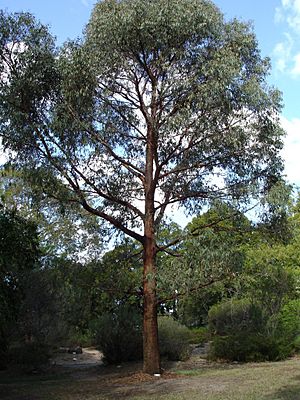Narrow-leaved peppermint facts for kids
Quick facts for kids Narrow-leaved peppermint |
|
|---|---|
 |
|
| Eucalyptus radiata, Melbourne | |
| Scientific classification | |
| Genus: |
Eucalyptus
|
| Species: |
radiata
|
The Eucalyptus radiata, also known as the narrow-leaved peppermint or Forth River peppermint, is a type of tree. It is found only in south-eastern Australia. This tree has rough, stringy bark on its main trunk and bigger branches. Its thinner branches have smooth, grey bark. The leaves are long and narrow, and its flower buds grow in groups of eleven to twenty or more. It has white flowers and fruit shaped like a cup or a half-sphere.
Contents
What it Looks Like
Eucalyptus radiata is a tree that usually grows to be about 10 to 50 meters tall. That's like a 3 to 16-story building! It has a special woody swelling at its base called a lignotuber. This helps the tree regrow if it gets damaged.
The tree's trunk and main branches have rough, grey bark that feels like fine fibers or flakes. But the smaller branches, thinner than 80 millimeters (about 3 inches), have smooth, grey bark.
- Young Plants and New Growth: Young trees and new shoots that grow from the base (called coppice regrowth) have leaves that are directly attached to the stem (sessile). These leaves are narrow and spear-shaped, 33 to 100 millimeters long and 5 to 20 millimeters wide. They are paler on the underside and grow in opposite pairs.
- Adult Leaves: The leaves on older trees are the same shade of green on both sides. They are also spear-shaped or slightly curved, 55 to 120 millimeters long and 6 to 15 millimeters wide. They narrow down to a stalk called a petiole, which is 5 to 16 millimeters long.
The flower buds grow where the leaves meet the stem (called the axil). They are on a short stalk called a peduncle, which is 2 to 12 millimeters long. Each individual bud has its own tiny stalk, a pedicel, which is 2 to 4 millimeters long.
When the buds are ready, they are shaped like a club, 3 to 5 millimeters long and 2 to 3 millimeters wide. They have a rounded or cone-shaped cap called an operculum. This cap is shorter and narrower than the base of the flower (the floral cup) where they join.
The tree blooms from October to January, and its flowers are white. After flowering, the fruit forms. It's a woody, cup-shaped, or half-sphere-shaped capsule. It's 3 to 6 millimeters long and 4 to 7 millimeters wide. The parts that open to release seeds (called valves) are almost level with the rim of the fruit.
How it's Classified
The Eucalyptus radiata was first officially described in 1828 by a scientist named Augustin Pyramus de Candolle. He wrote about it in his book Prodromus Systematis Naturalis Regni Vegetabilis, using notes from another scientist, Franz Sieber.
Later, in 1927, William Blakely described a similar tree called Eucalyptus robertsonii. Then, in 1973, two other scientists, Lawrie Johnson and Donald Frederick Blaxell, decided that Eucalyptus robertsonii was actually a type of Eucalyptus radiata. They called it a subspecies.
So, now there are two main types, or subspecies, of Eucalyptus radiata:
- Eucalyptus radiata subsp. radiata: This type has greenish-grey leaves. Its buds have a whitish, powdery coating (called glaucous), and the cap (operculum) on its buds is pointed.
- Eucalyptus radiata subsp. robertsonii: This type has green leaves. Its flower buds do not have the powdery coating, and its cap (operculum) is usually not pointed.
Where it Grows
The narrow-leaved peppermint tree grows in forests and woodlands. It prefers places that are cooler or wetter.
You can find it in:
- New South Wales, starting from near the Queensland border and going south.
- The Australian Capital Territory.
- Victoria, in places like the Wombat State Forest, Great Otway National Park, and the ranges of South Gippsland.
- Tasmania, but only near the Forth River.
The subspecies robertsonii is found only in the forests of north-eastern Victoria. These are often in high-up, mountainous areas (montane) or even higher, near the tree line (subalpine).
What it's Used For
The leaves of Eucalyptus radiata are special because they can produce six different types of essential oil. These oils are made by a process called distillation, where the leaves are heated to extract the oil. The oils are often based on chemicals like cineole and phellandrene.
Did you know that Eucalyptus radiata was the very first eucalyptus tree to be used to make oil for sale? A pharmacist from Melbourne named Joseph Bosisto started selling its oil in 1854. At that time, he called it "Eucalyptus amygdalina".
Images for kids
Gallery
- Features of the narrow-leaved peppermint (Eucalyptus radiata)
See also
 In Spanish: Eucalyptus radiata para niños
In Spanish: Eucalyptus radiata para niños













